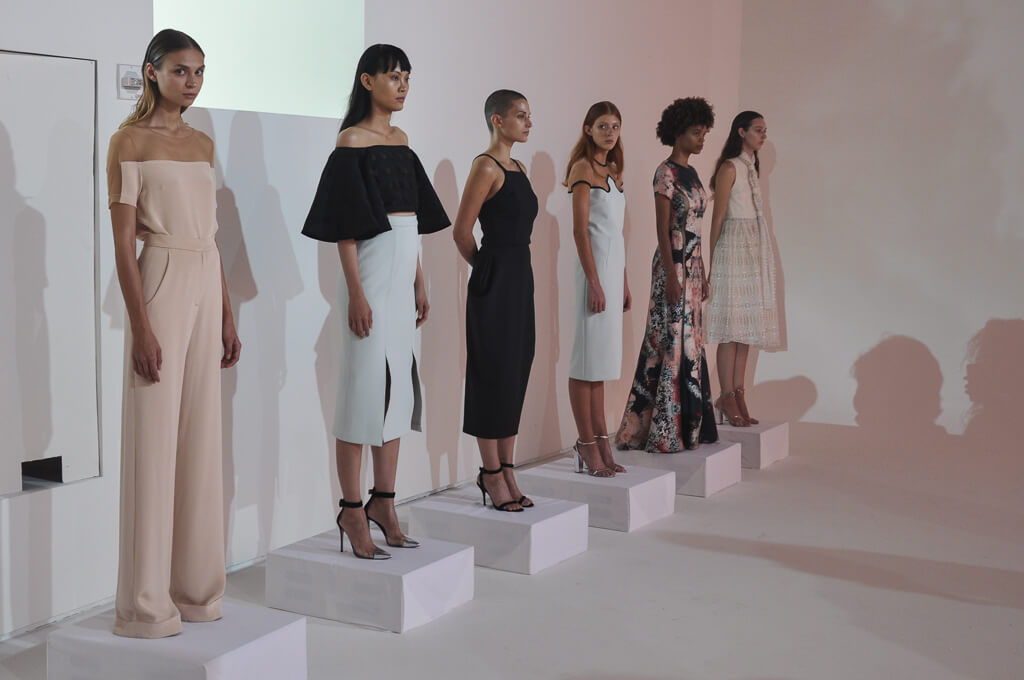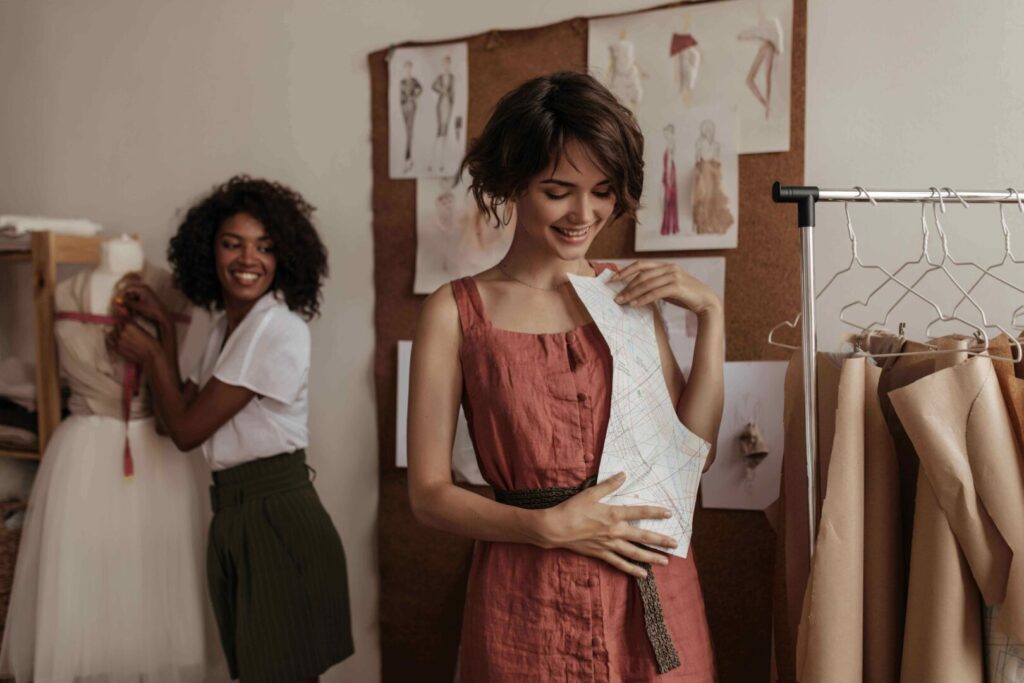Summary
- A fashion collection is a cornerstone of the industry, launched seasonally with unique themes
- These collections can grace runways or store shelves, prompting us to clarify what defines them
- Craft a complete fashion collection while managing every aspect of it with Audaces360 multi-solution. Try the free trial today!
“Fashion collection” is perhaps one of the most recurrent terms when talking about the fashion industry. Each season represents the launch of new collections, each with its unique themes aimed at diverse audiences.
Some collections grace the grand fashion runways, while others find their place on store shelves. Yet, at its core, what exactly is a fashion collection?
This question touches a complex realm, encompassing several factors: creativity, marketing strategies, trends, strict deadlines, and many other components.
To ensure the coherence of a collection, designers rely on established methodologies to streamline their creativity.
Sumário
Curious to unravel the processes behind the creation of a fashion collection and discover techniques that result in launches within shorter timeframes? Then explore the following content to gain more insights!
Happy reading!
What is a fashion collection and how does it work?
A fashion collection is like a carefully chosen group of clothes and accessories that all fit together.
They’re usually connected by a specific idea or style that matches what the brand stands for and what the people who might buy these clothes like.
A stylist’s creativity and ideas become real fashion through things like how the clothes are put together, the materials they’re made of, the colors used, and the shapes and cuts of each piece in the collection.
Most collections, whether they’re from fancy high-end brands or new ones just starting out, usually have two main types of items:
- Basics: These are clothes that are designed to be available for a longer time. You’ll often find them in regular clothing stores
- Fashion-forward items: These are trendier and only around for a short time. They might be a bit more unique and limited in how many are made.
How did the idea of fashion collections start?
Around 1850, Charles Fréderik Worth was one of the first couturiers to become a “creator,” which is similar to what we call a designer today.
Instead of only making clothes when someone ordered them, he started making clothes himself and offering them to customers.
To showcase these clothes, he hired women who had a similar body type to his clients. This was the beginning of the profession of models or mannequins.
But even with these innovations, there wasn’t a clear visual connection between the different pieces of clothing.
It wasn’t until the early 20th century, with Paul Poiret, that the concept of using a theme in fashion started to take shape.
He was inspired by oriental themes, although he didn’t quite create what we now call collections. He did, however, start using the idea of a theme for inspiration.
Around 1930, Elsa Schiaparelli was the first to develop fashion collections with specific themes.
These themes were seen in many pieces through prints, embroidery, and cutout designs. This marked the true beginning of what we now know as fashion collections.
How many pieces are in a fashion collection?
In a typical fashion collection (considering its size), you’ll usually find at least 12 pieces or looks.
But collections can vary in size, and this depends on things like the season, how long the collection will be available, the budget, and other factors.
Some collections are smaller and might have only 8 pieces; these are often called “capsule collections”.
On the other hand, larger brands might have collections with dozens of pieces. There isn’t a maximum number of pieces – it all depends on the brand’s sales strategy and budget.
Also, the type of clothes your brand makes can influence the collection’s size. Some brands might have more individual pieces, while others focus on creating complete outfits or looks.
Types of fashion collections

From a sales perspective, fashion collections can be categorized into two main types: conceptual and commercial.
Conceptual collections
Conceptual collections are designed to emphasize the theme that the designer has worked on.
They are based on concepts, ideas, and other sources of inspiration that guided the creation of the collection.
Because of their nature, the clothes showcased on the runway may not necessarily be practical for everyday wear.
These collections prioritize creativity and exploration rather than conforming to market wearability requirements or catering to current trends and the preferences of the target audience.
Commercial collections
Commercial collections are created with the primary objective of being sold.
They typically don’t emphasize the deep conceptual stage that conceptual collections do.
Instead, commercial collections rely on studies of fashion trends to develop sets of clothing and accessories that align with a specific theme and can be quickly delivered to consumers.
These collections are geared toward meeting consumer demand and market trends.
The power of storytelling in fashion collections
One of the key techniques used in crafting fashion collections is storytelling – the art of telling stories.
While the idea itself isn’t new, storytelling has been a part of human communication since ancient times.
However, recent studies have highlighted the significance of brands, including fashion collections, in storytelling.
The goal is to make the connection between the consumer and the product feel more human by creating emotional bonds and a sense of affection.
Learn more: 4 top tips for a successful fashion collection launch
How to create a fashion collection?
Creating a fashion collection involves several stages, from the initial idea to the final fashion show. These stages help streamline processes, reduce errors, avoid rework, and prevent delays. Here’s a simple guide:
Choose your collection type
There are two main types of collections: conceptual and commercial. Begin by deciding which one suits your goals and the market. This choice depends on various factors, including your brand’s objectives and the current fashion landscape.
Conduct market analysis
Fashion products are consumer goods, catering to an ever-changing audience with shifting trends.
Therefore, a thorough market analysis is essential for the success of your collection.
Study the market and trends, with a focus on influential European fashion trends, which often set the tone.
This analysis will help you determine the most suitable collection type, the number of pieces needed, and other crucial details.
Learn more: Uncover the benefits of fashion trend forecasting for your clothing business
Identify your target audience
Every fashion collection should have a specific target audience in mind.
While market research helps you understand emerging trends and consumer behaviors, defining a target audience helps narrow down the designer’s ideas.
It allows you to fine-tune the final pieces to cater to the chosen audience segment.
Collect as much information as possible about your target audience, including their socioeconomic background, consumer profile, age group, aesthetic preferences, and interests.
Create a collection timeline
Developing a collection timeline is a crucial step in ensuring a successful outcome.
This schedule manages the entire process, from sourcing materials and the creative design phase to production, packaging, and distribution.
Proper planning and strict adherence to the timeline are vital to avoid delays and unexpected setbacks that could cost you both time and money.
Define the collection theme
Determining the theme of your collection marks the beginning of the creative process. It starts with an analysis of trends, the preferences of your target audience, and the ideas of the fashion designer and stylist.
The theme should encompass various visual elements such as designs, cuts, fits, types of garments, color schemes, textures, fabrics, and all the aesthetic, ergonomic, and usability components that will be incorporated into the collection’s items.
Create sketches
The next step is to turn your ideas and theme into real designs through sketches. These sketches serve as a visual guide for the technical aspects of styling and pattern-making. They also provide an aesthetic foundation for the designer and the team to approve the models that will be part of the collection.
Learn more: Learn what digital sketching is and how to apply it to your fashion collection
Produce sample garments
Following the styling stage, the collection’s pieces move on to the modeling phase. Initially, detailed samples are created.
These prototypes help patternmakers create the necessary block patterns, and they serve as the foundation for producing sample garments.
During this phase, details such as fit, cut, and other characteristics are analyzed and approved by the team.
In modern fashion, the technical pattern-making process is often entirely digital, which streamlines the collection timeline.
Commence production
With the samples approved, it’s time to proceed with cutting the fabric patterns and start the actual production of the garments.
After production, the pieces undergo a final quality check to ensure they meet the desired standards.
Only then are they ready for the collection’s debut during the fashion show.
Where to find inspiration for your collection?

You can discover inspiration for your fashion collection from various sources, ranging from technical to creative fonts. Here are some places to explore ideas for your collections:
- Trend research during the collection design phase
- Major fashion events of the season
- Natural, ethnic, or historical elements
- Look to respected fashion magazines for insights and ideas
- Designer’s experiences and knowledge
Typically, the chosen theme for a collection combines elements from these various sources. The key is to incorporate references that not only look appealing but also align with the needs and expectations of your target audience.
How to name your fashion collection?
Naming your fashion collection may seem like a small detail, but it’s actually one of the most important elements.
The collection’s name is the first thing consumers see, and it plays a vital role in conveying the storytelling and concept behind your collection.
However, choosing the right name isn’t always an easy task. To help you decide, consider the following factors:
- References from your collection items
- The theme of your pieces
- The story your collection wants to tell
- Creative techniques to capture attention.
There are no strict rules for naming a collection, but ideally, the name should somehow represent the concept and the history behind the collection’s pieces that you’re presenting to the public.
Learn more: Learn how to choose the best clothing collection names
Automate and scale your fashion collection with Audaces

With three decades of experience, Audaces has played a significant role in automating and improving the efficiency and profitability of processes in the fashion industry.
One standout example is Audaces Isa, the world’s most comprehensive and technologically advanced fashion PLM (Product Life Cycle Manager).
It enables the management, control, and organization of the technical aspects of a collection while ensuring timely execution and informed decision-making in real-time.
Additionally, Audaces Fashion Studio allows you to swiftly create and recreate models in both real-time and virtual reality.
In essence, Audaces empowers you to design, manage, and integrate all the pieces in your collection with cutting-edge technology for the fashion industry.
Conclusion
Creating a fashion collection is a multi-step process that involves considering various factors such as trends, audience expectations, collection size, theme, and marketing approach.
These processes enable the creation of collections that are not just visually appealing but also profitable.
By optimizing the steps leading up to the runway launch, you can make the workflow more agile, accurate, efficient, sustainable, and ultimately, more profitable.
Now that you have a better understanding of fashion collections, why not explore how Audaces technologies an effective planning can transform your clothing business?
Click on the link below, fill out the form, and download a free canvas template to optimize your fashion collection launches!
FAQ
A collection is a set of related clothing and accessories.
Typically, at least 12 pieces/looks.
Choose the collection type, do market analysis, identify the target audience, define the theme, and produce pilot pieces.










